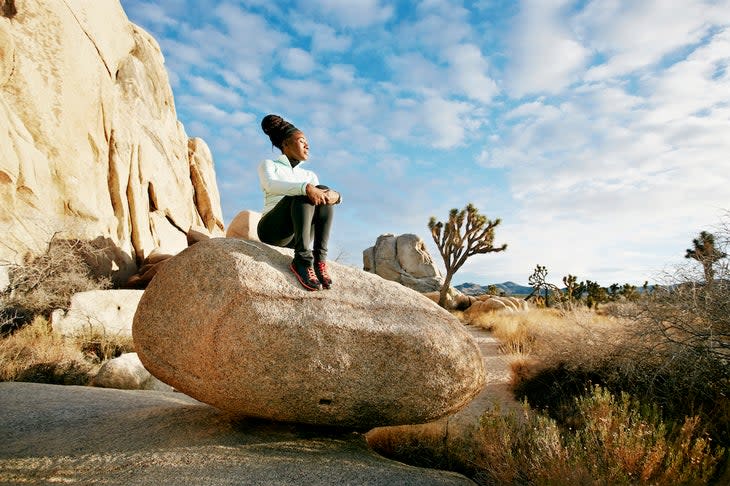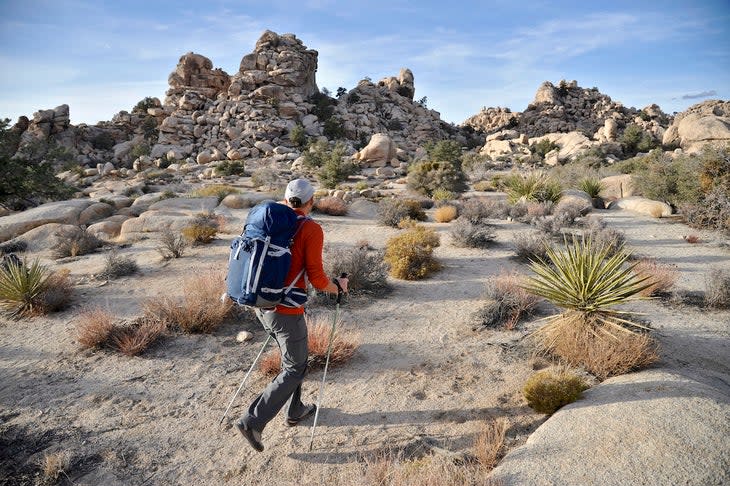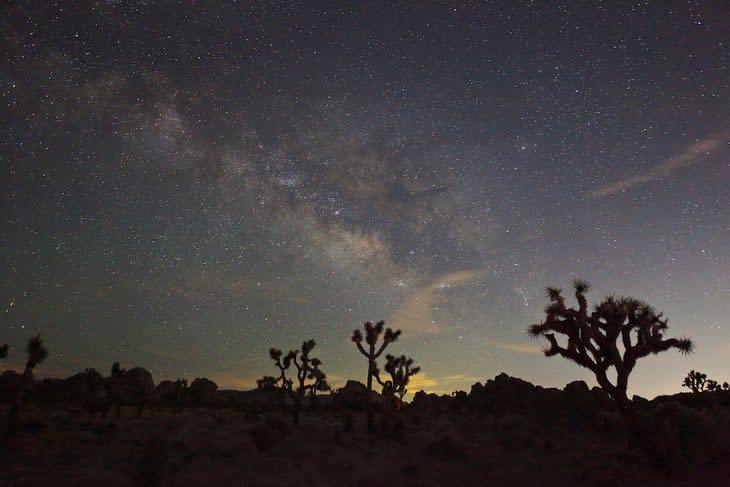The Best Hikes in Joshua Tree National Park
This article originally appeared on Backpacker
A hike through Joshua Tree National Park is like trekking through a fairytale land. Whimsical rock formations, colossal granite boulders, and spindly Joshua trees that grow in abundance in the Mojave Desert make this park one of the most iconic desert hiking spots in the country.
Another thing to love about the park: It’s a kaleidoscope of colors year-round. Fiery sunrises and sunsets and sparkling constellations light up the sky. In early spring, wildflowers bloom out of cacti and desert foliage across the lower-elevation Pinto Basin, and at higher elevations, flowers erupt between March and April. Whether you're looking for a quick hike or a multiday adventure, you won't be disappointed with a trip to Joshua Tree.
Best Dayhikes in Joshua Tree
Day hike through groves of Joshua trees, beautiful rock formations, and sweeping views of the park's classic Mojave desert landscape.
Panorama Loop
Length: 6.6 miles
Elevation Gain: 1,194 feet
Trail Type: Lollipop loop
Difficulty: Moderate
You'll be hard-pressed to find a more densely-populated grove of Joshua trees in the park than Black Rock Canyon, the stomping ground of the Panorama Loop. Aptly named, the Panorama Loop boasts some of the best views of the park along with stands of twisty and spiky-branched Joshua trees, covering nearly 7 miles of pristine desert topography. The epic lookout at the top makes it hard for any hiker to pass on at least one snapshot: a 360-degree view of Mt. San Jacinto, the Coachella Valley, Yucca Valley, and the snow-capped San Gorgonio Mountain. Bonus: An optional side trip at the junction at mile 4.3 (for clockwise hikers) leads to Warren Peak, adding an extra 1.4 miles round-trip.
Lost Palms Oasis
Length: 7.5 miles
Elevation Gain: 1,046 feet
Trail Type: Out and back
Difficulty: Moderate
Venture to a lush oasis in the middle of the desert at Lost Palms. Even though this hike is quite a trek, it's totally worth it. Just plan to break a sweat along the way. The trail travels through miles of dramatic rock formations before leading to a grove of hidden palms tucked away in a boulder and yucca-filled canyon. The giant California fan palms thrive here thanks to spring-fed pools scattered around the narrows in the area. The trail ends before you reach the grove of palm trees, so continue at your own risk if you try and check them out at a closer vantage point.
Ryan Mountain Trail
Length: 2.8 miles
Elevation Gain: 1,034 feet
Trail Type: Out and back
Difficulty: Moderate
Ryan Mountain challenges even the toughest hikers. This exposed, steep, and technical trail includes several sections of rocky stairs carved out of the natural landscape, and leads to a 5,457-foot summit in the heart of the park. Along the way, take in views of the Wonderland of Rocks (a popular rock climbing spot) and the Little San Bernadino Mountains in the distance. At the top, hikers reap a soaring vantage point of sprawling desert dotted with jagged rock formations and far-away mountain ridgelines in every direction.
Arch Rock Trail
Length: 1.4 miles
Elevation Gain: 88 feet
Trail Type: Out and back
Difficulty: Easy
Make this short and sweet day hike one of many during your time in the park. A stone-lined trail leads hikers through light tan-colored boulders in wild shapes and eccentric rock formations rising over 10-feet-tall in nearly every direction. Just over a half-mile into the hike, the 12-foot-tall and 30-foot-wide arch comes into view. Into camping? Check out White Tank Campground, the closest camping spot to this popular spot in the park. A path near campsite 9 leads to Arch Rock (perfect for avoiding heavy foot traffic).
Wonderland of Rocks via Boy Scout Trail
Length: 5.5 miles
Elevation Gain: 147 feet
Trail Type: Point to point
Difficulty: Moderate
Take in the iconic Mojave desert landscape along the Boy Scout Trail as you pass dense stands of Joshua trees, towering granite boulders, and sand-colored granite rock formations. Wonderland of Rocks is one of the premier rock climbing locations in the national park, so expect to run into a few rock climbers on this route.

Best Family Hikes in Joshua Tree
Joshua Tree is full of short, accessible, interpretive trails fit for kids of all ages. Explore one of these popular family-friendly desert hikes with the whole crew.
Cholla Cactus Garden
Length: 0.2 miles
Elevation Gain: 9 feet
Trail Type: Loop
Difficulty: Easy
In this garden, there’s one rule: You can look, but you can’t touch. Its furry texture might fool you, but the cholla cactus is as spiky and pesky as they come, with needles that stick in the skin and segments that detach as soon as you brush into them. This short but popular loop trail winds through a 10-acre swath of one of the largest concentrations of cholla cacti in the southwest. Many other plant and cactus species, like purple desert lavender, yellow desert senna, and pink beavertail cactus, also grow in this lush desert region. Hike here in April through June to get a glimpse at the cacti in full bloom.
Discovery Trail
Length: 0.7 miles
Elevation Gain: 68 feet
Trail Type: Loop
Difficulty: Easy
What's more kid-friendly than a kid-built trail? Designed by local students in 2013, the Discovery Trail features interpretive signs that guide hikers through the geological history that shaped this region, including the formation of molten rock that formed the monzogranite features over 100 million years ago. Highlights along the brief hike include Face Rock, fixed binoculars to scope out the surrounding landscape, and a number of short slot canyon passes and rock scrambles. A number of other trails--including Skull Rock and Split Rock trails--link up to the Discovery Trail loop, making it a perfect spot in the park to spend a day with the family.
Skull Rock Trail
Length: 1.7 miles
Elevation Gain: 160 feet
Trail Type: Loop
Difficulty: Easy
Joshua Tree is full of astonishing boulders, but none quite compare to the over 20-foot-tall granite skull-shaped rock rising out of the desert floor. The trail to “Skull Rock” is a favorite in the park, but kids in particular love exploring this two-mile path. Hiking clockwise, pass Skull Rock at the very start of the trail, followed by a quick section through Jumbo Rock Campground and several boulder fields, before closing the loop. If you’re hoping to avoid crowds, then you should hit this trail early in the morning.
Split Rock Loop
Length: 2 miles
Elevation Gain: 149 feet
Trail Type: Loop
Difficulty: Easy
Kids will love the extra challenge of climbing boulders, exploring rocky caves and slot canyons, and trekking up natural rock staircases along Split Rock Loop. You'll see Split Rock, a boulder with a vertical split right down the center near the trailhead. The remaining scenery along the 2.5-mile journey, though, is the real reason why hikers frequent this trail. Huge piles of SUV-sized granite boulders, which look more like giant blobs of dripped sand, turn the route into a natural art gallery. We also recommend taking the short 0.2-mile spur around 1.3 miles in (if you hike counter-clockwise) that leads to Face Rock, a giant granite boulder resembling the profile of a human head.

Best Backpacking Trip in Joshua Tree
Looking for a longer hike in Joshua Tree? We've got you covered. Pro tip: It's best to plan your long hikes in October through May, the coolest times of the year here.
California Riding and Hiking Trail
Length: 36.4 miles
Elevation Gain: 3,177 feet
Trail Type: Point to point
Difficulty: Hard
Why just sample Joshua Tree when you can get a taste of it all in one trip? This mini thru-hike takes hikers through the most remote parts of the park. Hike it west to east (Black Rock Canyon Campground trailhead to the North Entrance Backcountry Lot) to tackle the steepest part of the route in the beginning. You'll find many points of interest along the route, including views of the over 5,400-foot-high Ryan Mountain, a stint through Juniper Flats and the Twin Tanks water reservoirs, and an optional half-mile spur to Arch Rock.
You’ll need to prep: With a hike this long, and temperatures this hot, water caches (spots where you stash water along your route) are a must, so plan accordingly. There aren’t many natural sources where you can filter water. Also, popular campsites include Ryan, White Tank, and Belle Campgrounds, Quail Mountain (the steepest in the park), and backcountry sites before and after Geology Tour Road.

Tips for Hiking in Joshua Tree
When to Go
If you want to avoid high heat, then you should plan your trip during the shoulder seasons, October through May. The park reaches scorching hot temperatures during the summer between July and September. Average temperatures in summer hover around 99 degrees with lows in the 70s. Hikers should be cautious when hiking in hot conditions and opt for early-morning hikes to avoid over-exposure to heat.
What to Pack
The National Park Service recommends at least one gallon of water per day per person when hiking in Joshua Tree. Summer hikers should consume at least two gallons. Be sure to pair that with salty snacks or electrolyte drink mixes to avoid hyponatremia (what happens when your sodium levels get too low). Symptoms of hyponatremia are nausea, headaches, confusion, muscle cramps, and fatigue. If you start developing these symptoms, then be sure to have something salty, like a handful of pretzels or a tablet or two of Nuun.
Whether you’re out all day or just for a couple miles, at a minimum, hikers should drink one liter of water for every two hours on the trail. Plan to pack a hat, sunscreen, breathable boots, and moisture-wicking and quick-dry clothing, and pack extra water jugs to fill up in town or at the West Entrance, Oasis, or Cottonwood Visitor Centers, or Indian Cove Ranger Station. Desert nights can drop into the low 30s, so pack warm clothes and an appropriately-rated sleeping bag.
Where to Stay
Take your pick of eight different campgrounds in Joshua Tree National Park. First-come, first-serve sites are available at Hidden Valley, Ryan, White Tank, and Belle--and fill up fast. Book Black Rock, Indian Cove, Cottonwood, or Jumbo Rock campgrounds in advance.
The Famous Joshua Trees
The park's namesake, the Joshua trees (Yucca brevifolia), characterize the Mojave Desert landscape and ecosystem. But these trees aren't actually trees at all. In fact, they're large succulents. Their fibrous trunks, spindly and whimsical branches, and bushels of spiky leaves provide food and shelter for animals and insects throughout the desert. Each plant can live up to 500 years old. Today, Joshua trees are protected under the California Endangered Species Act due to the threat of human harvesting and the impact of climate change.
For exclusive access to all of our fitness, gear, adventure, and travel stories, plus discounts on trips, events, and gear, sign up for Outside+ today.